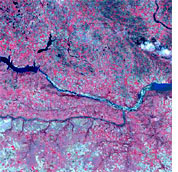

| Calibration and Validation | |||

The data from these satellites cannot easily be compared and integrated for the detection, monitoring and characterization of global change without calibration to common units of measurement. Calibration is essential to the role of Landsat 7 in the Earth Observing System era. Landsat 7 will be launched as part of a planned constellation of satellites dedicated to Earth observations. The Enhanced Thematic Mapper Plus aboard Landsat 7 will be calibrated accurately in order to use its data in concert with the data from the other satellites and thereby realize the full potential of the integrated remote sensing systems under development by the Earth Science Enterprise. The inclusion of a new full-aperture-solar-calibrator and a partial-aperture-solar-calibrator on Landsat 7 will afford improved calibration relative to the earlier Thematic Mapper and Multi-Spectral Scanner sensors on Landsats 4 and 5. These two devices will permit use of the sun, with its known exo-atmospheric irradiance, as an absolute radiometric calibration source. The data provided by the on-board solar calibrators, in conjunction with an internal calibration lamp and occasional ground-based validation experiments, will permit calibration to an uncertainty of less than five percent. This level of accuracy is consistent with the radiometric requirements for the Earth Observation System sensors. Management
As the operational era begins, Landsat 7 is transitioning to a dual-agency program between NASA and USGS. The transition and management have been governed by a joint management plan agreed to by the three agencies; future management will be governed by a bilateral Memorandum of Understanding between NASA and USGS. The Landsat Project, located at the Goddard Space Flight Center, manages Landsat development for NASA's Office of Earth Science in Washington, D.C. USGS operations will be performed at a Mission Operations Center at the Goddard Space Flight Center and at the EDC in Sioux Falls, SD. Landsat 7 is part of a global research program known as NASA's Earth Science Enterprise, a long-term program that is studying changes in Earth's global environment. The goal of the Earth Science Enterprise is to provide people a better understanding of natural environmental changes. Earth Science Enterprise data, which will be distributed to researchers worldwide at the cost of reproduction, is essential to people making informed decisions about their environment. back: Landsat Ground System
|

Landsat 7
| ||